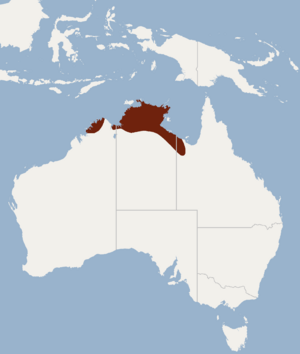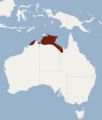Pygmy long-eared bat facts for kids
The pygmy long-eared bat (Nyctophilus walkeri) is a tiny bat that lives in northern Australia. It's a flying hunter that eats insects. This bat is one of Australia's smallest mammals, weighing only a few grams and measuring just a couple of inches long.
Quick facts for kids Pygmy long-eared bat |
|
|---|---|
| Conservation status | |
| Scientific classification | |
 |
Contents
Discovering the Pygmy Long-Eared Bat
The pygmy long-eared bat belongs to a group of bats called Nyctophilus, which are known for their long ears. These bats are part of a larger, very common bat family called Vespertilionidae.
A scientist named Oldfield Thomas first described this bat in 1892. He named it walkeri to honor James John Walker, a marine engineer and insect expert who collected the first bat specimen near the Adelaide River in the Northern Territory.
People sometimes call this bat the Territory long-eared bat or the little Northern Territory bat.
What Does the Pygmy Long-Eared Bat Look Like?
The pygmy long-eared bat is the smallest bat in its group. It weighs only about three to seven grams, which is super light! Its lower leg bone (tibia) is about 30 to 36 millimeters long. The first bat ever studied, an adult female, was about 45 millimeters long from head to body.
Its fur is light fawn (a pale brownish-yellow) on its back and creamy white on its belly. Its wings are brown, but the skin between its arm and finger bones is a bit lighter.
Where Do Pygmy Long-Eared Bats Live?
These bats are found in the northern parts of Australia. You can find them in the Kimberley region of Western Australia and across the Top End of the continent. They are quite common in places like the Drysdale River National Park and the Mitchell River National Park (Western Australia).
They have also been seen in Queensland, at Lawn Hill Gorge in the Boodjamulla National Park. Here, they sometimes make a lot of noise while resting in Livingstonia palm trees!
Pygmy long-eared bats like to live near rocky areas close to water, like rivers or streams. They also live in thick forests or woodlands with plants like pandanus, melaleuca, and Livistona trees.
Pygmy Long-Eared Bat Habits
The pygmy long-eared bat is one of the smallest mammals in Australia. Not much is known about its daily life, but it's always found near permanent water sources and the plants growing around them.
This bat can fly slowly and change direction easily. This makes its flight look fluttery, especially when it's hunting for food over water or in thick forests. Its diet mainly consists of insects like beetles, wasps, and bugs.
Unfortunately, human activities like farming and ranching can harm the bat's home. Changes in how land is used can reduce the places where bats can rest and find food. However, the pygmy long-eared bat is currently listed as "least concern" for conservation in Queensland and the Northern Territory, meaning it's not in immediate danger.
Images for kids
See also




